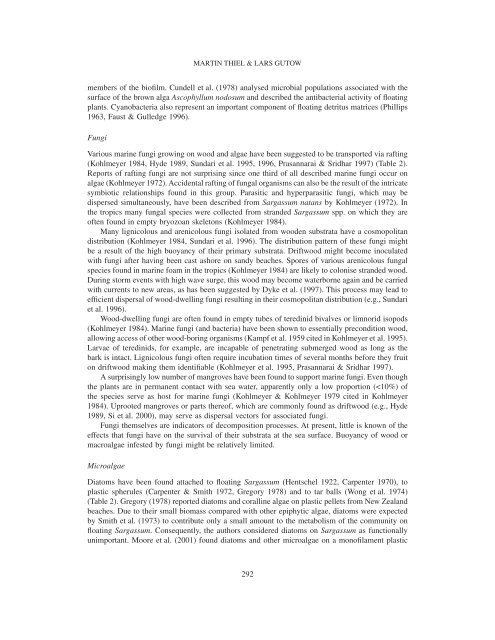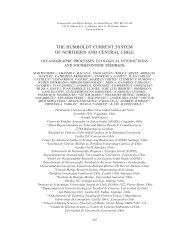The ecology of rafting in the marine environment - Bedim
The ecology of rafting in the marine environment - Bedim
The ecology of rafting in the marine environment - Bedim
Create successful ePaper yourself
Turn your PDF publications into a flip-book with our unique Google optimized e-Paper software.
MARTIN THIEL & LARS GUTOW<br />
members <strong>of</strong> <strong>the</strong> bi<strong>of</strong>ilm. Cundell et al. (1978) analysed microbial populations associated with <strong>the</strong><br />
surface <strong>of</strong> <strong>the</strong> brown alga Ascophyllum nodosum and described <strong>the</strong> antibacterial activity <strong>of</strong> float<strong>in</strong>g<br />
plants. Cyanobacteria also represent an important component <strong>of</strong> float<strong>in</strong>g detritus matrices (Phillips<br />
1963, Faust & Gulledge 1996).<br />
Fungi<br />
Various mar<strong>in</strong>e fungi grow<strong>in</strong>g on wood and algae have been suggested to be transported via <strong>raft<strong>in</strong>g</strong><br />
(Kohlmeyer 1984, Hyde 1989, Sundari et al. 1995, 1996, Prasannarai & Sridhar 1997) (Table 2).<br />
Reports <strong>of</strong> <strong>raft<strong>in</strong>g</strong> fungi are not surpris<strong>in</strong>g s<strong>in</strong>ce one third <strong>of</strong> all described mar<strong>in</strong>e fungi occur on<br />
algae (Kohlmeyer 1972). Accidental <strong>raft<strong>in</strong>g</strong> <strong>of</strong> fungal organisms can also be <strong>the</strong> result <strong>of</strong> <strong>the</strong> <strong>in</strong>tricate<br />
symbiotic relationships found <strong>in</strong> this group. Parasitic and hyperparasitic fungi, which may be<br />
dispersed simultaneously, have been described from Sargassum natans by Kohlmeyer (1972). In<br />
<strong>the</strong> tropics many fungal species were collected from stranded Sargassum spp. on which <strong>the</strong>y are<br />
<strong>of</strong>ten found <strong>in</strong> empty bryozoan skeletons (Kohlmeyer 1984).<br />
Many lignicolous and arenicolous fungi isolated from wooden substrata have a cosmopolitan<br />
distribution (Kohlmeyer 1984, Sundari et al. 1996). <strong>The</strong> distribution pattern <strong>of</strong> <strong>the</strong>se fungi might<br />
be a result <strong>of</strong> <strong>the</strong> high buoyancy <strong>of</strong> <strong>the</strong>ir primary substrata. Driftwood might become <strong>in</strong>oculated<br />
with fungi after hav<strong>in</strong>g been cast ashore on sandy beaches. Spores <strong>of</strong> various arenicolous fungal<br />
species found <strong>in</strong> mar<strong>in</strong>e foam <strong>in</strong> <strong>the</strong> tropics (Kohlmeyer 1984) are likely to colonise stranded wood.<br />
Dur<strong>in</strong>g storm events with high wave surge, this wood may become waterborne aga<strong>in</strong> and be carried<br />
with currents to new areas, as has been suggested by Dyke et al. (1997). This process may lead to<br />
efficient dispersal <strong>of</strong> wood-dwell<strong>in</strong>g fungi result<strong>in</strong>g <strong>in</strong> <strong>the</strong>ir cosmopolitan distribution (e.g., Sundari<br />
et al. 1996).<br />
Wood-dwell<strong>in</strong>g fungi are <strong>of</strong>ten found <strong>in</strong> empty tubes <strong>of</strong> tered<strong>in</strong>id bivalves or limnorid isopods<br />
(Kohlmeyer 1984). Mar<strong>in</strong>e fungi (and bacteria) have been shown to essentially precondition wood,<br />
allow<strong>in</strong>g access <strong>of</strong> o<strong>the</strong>r wood-bor<strong>in</strong>g organisms (Kampf et al. 1959 cited <strong>in</strong> Kohlmeyer et al. 1995).<br />
Larvae <strong>of</strong> tered<strong>in</strong>ids, for example, are <strong>in</strong>capable <strong>of</strong> penetrat<strong>in</strong>g submerged wood as long as <strong>the</strong><br />
bark is <strong>in</strong>tact. Lignicolous fungi <strong>of</strong>ten require <strong>in</strong>cubation times <strong>of</strong> several months before <strong>the</strong>y fruit<br />
on driftwood mak<strong>in</strong>g <strong>the</strong>m identifiable (Kohlmeyer et al. 1995, Prasannarai & Sridhar 1997).<br />
A surpris<strong>in</strong>gly low number <strong>of</strong> mangroves have been found to support mar<strong>in</strong>e fungi. Even though<br />
<strong>the</strong> plants are <strong>in</strong> permanent contact with sea water, apparently only a low proportion (










